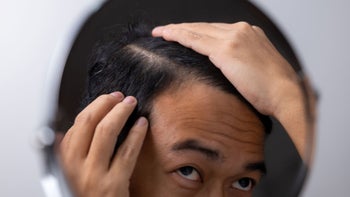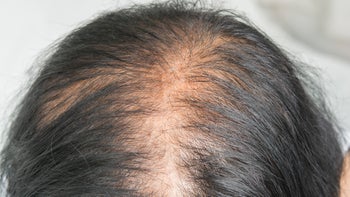
Minoxidil Foam vs. Liquid for Hair Loss: 4 Differences to Consider
Key takeaways:
Minoxidil (Rogaine) is available over the counter (OTC) to treat hair loss in men and women. It comes in a few different forms and concentrations, including a topical foam and liquid solution that you apply directly on the scalp.
Minoxidil foam can be less irritating compared to the liquid and may be easier to apply. The minoxidil liquid solution may be better for more targeted application through long or thick hair. Which product is right for you depends on your personal preferences.
Insurance plans don’t typically cover any forms of topical minoxidil. But GoodRx can help you save on OTC minoxidil if you get a prescription from a healthcare professional.
Access savings on related medications
Table of contents

Minoxidil (Rogaine) is one topical hair-loss product that you may see on pharmacy shelves. It comes in a few different forms and concentrations, including a topical foam and liquid solution. But which one should you choose?
Minoxidil foam and liquid have a few similarities. For example, they’re both available over the counter (OTC), applied twice a day, and need to be used continuously for several months before you’ll see results. But potential side effects, how you apply them, and how quickly they dry are a few differences to consider. We cover these differences and more below.
1. Minoxidil foam may be less irritating than the liquid
The minoxidil liquid solution contains propylene glycol. This ingredient helps mix minoxidil into the liquid. It also helps minoxidil reach your hair follicles. But it can cause allergic reactions and skin irritation for some people, including a rash, flaky skin, and itching.
To reduce irritation, a foam version of minoxidil was developed that doesn’t contain propylene glycol. Studies have shown that people who use the foam don’t have as much burning, itching, and flaking skin.
If you experienced irritation from minoxidil liquid, you may consider trying a lower strength or the foam. But be careful — some foams are made with propylene glycol. Ask your pharmacist if you need help finding a minoxidil product that doesn’t contain this ingredient.
If you’re still experiencing irritation after switching products, you may be allergic to minoxidil itself. In this case, you should follow up with your healthcare team for guidance.
2. Minoxidil foam may be easier to apply than the liquid
One advantage of the minoxidil foam is that it may be easier to apply than the liquid. Both forms are applied directly to the area where you want to treat hair loss. But some research has shown that the foam may be preferred when it comes to ease of application.
People also like that the foam dries fast and doesn’t drip as much. Minoxidil foam is made to evaporate off of your skin quickly — within 30 seconds. It doesn’t usually leave a residue on the skin afterwards, unlike the liquid form that can sometimes feel greasy.
When applying minoxidil foam, make sure to spray the foam into cold hands, since it melts quickly. Then, massage it into the areas where you want to treat hair loss.
Minoxidil side effects: Are you experiencing scalp irritation after starting minoxidil? Here’s a list of potential minoxidil side effects and how to manage them.
Can it affect your sex life? Certain hair-loss medications can affect your sex life. But is this the case for minoxidil? Here’s what the evidence says about potential sexual side effects.
Minoxidil FAQs: Learn more about how long minoxidil takes to work for hair loss, plus what happens when you stop using it.
3. Minoxidil liquid may be better for thick or long hair
If you have long or thick hair, you may prefer minoxidil liquid over the foam.
Minoxidil liquid comes with a dropper or in a spray bottle. This allows for more targeted application to reach areas on your scalp through long or thicker hair. Just remember that you’ll still need to massage the medication into your scalp with your fingers after applying it.
4. Minoxidil liquid may cost less than the foam
Insurance plans, including Medicare Part D, usually don’t cover topical minoxidil. How much you’ll pay depends on whether you’re buying a brand-name or generic product and the formulation you choose. Generic versions typically cost less when compared to their brand-name counterparts. And before discounts, minoxidil liquid may cost slightly less than the foam at certain pharmacies.
You can save on OTC medications like minoxidil by using a free GoodRx coupon. But you’ll need a prescription from a healthcare professional in order to use the coupon at the pharmacy.
With a GoodRx coupon, the price for one bottle is as low as $6.92 for minoxidil 2% liquid and as low as $11.57 for minoxidil 5% liquid. This is compared to one can containing 60 g of foam that costs as low as $9.68.
The bottom line
Minoxidil (Rogaine) is an over-the-counter topical hair-loss treatment for men and women. It comes in different concentrations and formulations, such as a liquid and foam. Which form of minoxidil you use comes down to personal preference.
Minoxidil liquid may be more irritating than the foam, but it can allow for more targeted application. The foam dries faster and doesn’t drip as much. You can save money on topical minoxidil by using a free GoodRx coupon with a prescription.
Why trust our experts?



References
Avacor Products, LLC. (2023). 5% Minoxidil topical solution- minoxidil solution [package insert]. DailyMed.
BJWC. (2022). Berkley and jensen minoxidil- minoxidil aerosol, foam [package insert]. DailyMed.
Friedman, E. S., et. al. (2002). Allergic contact dermatitis to topical minoxidil solution: Etiology and treatment. Journal of the American Academy of Dermatology.
Gogtay, J. A., et. al. (2009). Minoxidil topical foam: A new kid on the block. International Journal of Trichology.
Hasanzadeh, H., et. al. (2016). Efficacy and safety of 5% minoxidil topical foam in male pattern hair loss treatment and patient satisfaction. Acta Dermatovenerologica.
Suchonwanit, P., et. al. (2019). Minoxidil and its use in hair disorders: A review. Drug Design, Development and Therapy.
Was this page helpful?
Related Articles
Browse medications
View AllResearch prescriptions and over-the-counter medications from A to Z, compare drug prices, and start saving.














